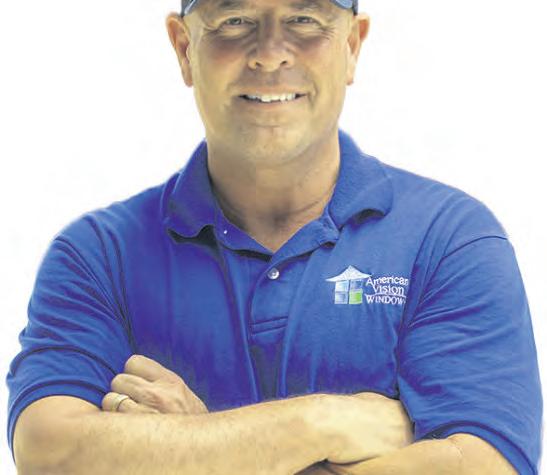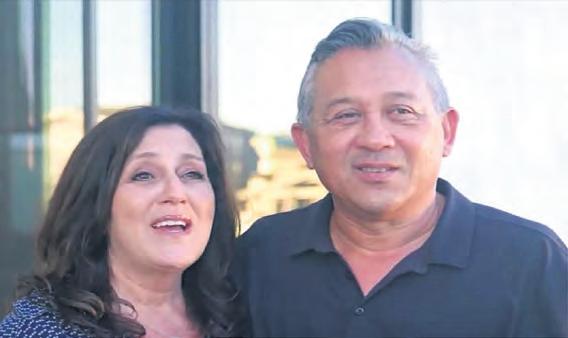
7 minute read
ONEOFTHEIR OWN
policeforhispossibleinvolvementinthemurderofCarol
DeFelice, a prostitute.He was never charged inthatcase.
Advertisement
Then,in June 1985,a 16-yearold girlwhosecarhadbroken downon University Avenuein La Mesa was offeredhelpby a manin abluevan.After she got in he tried to subdueherwith a stun gun andorderedher to sitbetween theseats.Shescreamed, foughthim off,andescaped, memorizingthevan’s license plate numberasshe fled.
Theplate was registered to Tatro. Policefoundhimathis sister’s house,inthebackofthe van He was naked onthe floor, bleeding frombothwrists. Two razorblades were nearby, as was apornographicmagazinedepictingbondage andsadomasochism He’d writtena note leaving allhispossessions to hissister. He was taken to a hospital, andthen to court,where he pleaded guilty and was sentenced to threeyearsinprison “I want psychiatric help,” Tatro tolda probationofficer, “and I want to livea normallife.”
Whenhe got outofprison,he was sent back to Arkansasfor violatinghisparolethere and eventually woundupin Tennessee.On Aug.24,2011 27 years to thedayafter Hough’s body was found Tatro drownedinwhat authorities ruleda boating accident on a river.
Was thedatea coincidence or amessage? Tatro’s hat,glasses and wallet were still ontheboat, tucked awaysafely Officialssaid it appearedhe wentinto the water onpurpose.
Ifit wasa suicide,it was the secondoneinvolving someone associatedwiththeHoughcase. Andnotthelast.
In every oneof Tatro’s crimes,heactedalone,a possible red flagfor detectivestrying to connecthim to KevinBrown,thecriminalist Ornot.
Lambert’s experience workingallsortsofcases, from lowlevel misdemeanors to murder, taughthimthat “there are many times where people actedalone whenthey were outthere,and thenthere are instanceswhere thosesame people whoactalone incrimeswillalsoactin concert orwithotherpeopleinother crimes.”
Sodetectives keptlookingfor links,andbeganmaking plans to search oneplacewhere they thoughttheymight findthem: Brown’s house.
Althoughthecriminalisthad left theSanDiego Police Department a decadebefore hisDNA showed upintheHoughcase, he was stillinthearea.Heshareda two-story, three-bedroomhome inChulaVista withhiswife Rebecca,hermother andoneofher brothers.
After quittinghisSDPD job— hisbosses hadmadeitclearhis difficulty onthewitness stand jeopardized his continuedemployment— he returned toNew Mexico andthestate crimelab for a few years Thenheandhis wifecameback to SanDiego, where he workedinanelectronicsstore until he was 55, old enough to begindrawinghis policepension.
Lambert expectedatsome point to try to interview Brown, buthe workedaroundtheedges first,talking to criminalists who knew him fromthelab.
Helearnedthings that roused hissuspicions. Brown had a nicknameamong co-workers: “Kinky Kevin.”It stemmed from a fondness for strip clubsandnudephotography activitieshepursued during his first decadehere,whilehe was abachelor.
Severalofhisformer colleagues told LambertthatBrown didn’t just goto stripclubs he bragged aboutthevisits.They saidBrown also regaledthem withtalesoforganized photo shootsinvolvingnakedmodels, includingonein a hotelthat was raidedbythevicesquad.Heonce asked a female employeeto pose forhim.
Annette Peer a retiredcriminalistwhofoundBrown “creepy,” saidshe wasalonewithhimin thelabonedaywhenhestarted reading outloud from a police report.Criminalistsdidthis from time to time,laughingatsections theyfoundodd oramusing.
There was nothingfunny about the report Brown had, Peer toldthedetective.Itdetailed a sexualassault “very violent.”Peer couldn’t understand whyBrown hadthe report inhisdesk,letalonewhyhe chose to share itwith her.
PeersaidBrown alsobrought apornographic movie to work onedayandshowed it to several male colleagues. Strippers nudemodels,porn —Lambert wonderedifthose were theshadowy worldswhere
Ronald Tatro was linkedbyDNA to theHough case, too,and cold-case detectivestried in vain to find evidence connectinghim to Brown. Thisphoto was takenin 1984,the same yearHough wasslain.
TOP,clockwise fromupperright: ClaireHoughand aportionofher autopsy report.
Ronald Tatro,a portionofa case toxicology report andaphotoof Tatro’s van. Aportionofa SanDiego Police departmentpress releaseaboutthe caseanddepictionsofaDNA strandandspermatozoa.
KevinBrown, drawings from aninvestigator’s evidencenotes regardingblood onHough’s pants andaphotoofher blouse.
A SanDiego PoliceDepartmentphotoof thebridgeabove whereHough’s body wasfound andaportionof the case’soriginal evidencelist.
Brown and Tatro met.Birdsofa feather?
Bytheendof2013 thedetectives were ready to approach Brown directly.
Aconfessionisoften themost powerful evidenceprosecutors presentin a criminaltrial, so detectives work hard toobtain them Lambert toldPeerthathe might have to “sweat Brown to closethecase.(“God, I wishI could be a fly onthe wall,”she replied.)
Lambert alsosoughtpermission to search Brown’shouse.In early January 2014, he fileda 34-page affidavitoutlining the history ofthecase,theDNA results andthe“Kinky Kevin” stories Itsaidthecrimelabhad determinedthat contamination “is notpossible”asan explanationforBrown’s spermshowing upinthe evidence. SuperiorCourt Judge Frederic Linksignedthe warrant.It authorizedpolice to take cellphones, computers newspaper clippings,photographs andother itemsthatmighthave information relating to Hough, Tatro or themurderinvestigation.
Ateam was assembled About adozenpoliceofficers waited outsidewhile LambertandAdams walked to the frontdoor. They had notinformedBrown they werecoming.Hedidn’t know he was underinvestigation.
Brown answeredtheknockon thedoor It was about8:30 a.m. andhe was still inhispajamas and robe.“Good morning,”he said,andallowedthem in.
Lambert saidthey wanted Brown’s help withsomeoldhomicidecasesinvolvingprostitutes. Heshowed Browna photo ofone ofthevictims,killed in February 1984.Brown didn’t recognizeher.
There’s a man we believe might beinvolvedinthemurder, thedetective said. Maybe you know him.
Theman was Tatro.The detectivessaidhehadbeen contactedbypoliceinSeptember
1984.That wouldhave beenone month after Hough was murdered.He was parkedin a Dodge vanonElCajonBoulevard,inan area frequentedbyprostitutes, theysaid.
Anofficer filled out a field interview card,andontheback scrawleda note: Tatro said he knows a SDPDemployee named Kevin Brown. Noneofthat was true.There was nopolicestop,no fieldinterview card,noclaim by Tatrothat heknew Brown. This isknownas a ruse,and it’s beendeemedlegalbythe courts. Policecanlie to a suspect whilepursuing a confession,as long astheydon’tcrosstheline into illegal coercion.But just where to draw thatlineis controversial,andseveral states— Oregon, Illinois, New York— have passedorproposedlaws to curtailfalsehoods.
Thedetectivesshowed Brown aphoto of Tatro and anotherone ofhisvan.“Maybe you were buddies atthetimeorsomethinglike that,” Lambert said,suggesting the two mighthave met at a strip club or a bar.
“Itdoesn’tring a bell,”Brown said.
“Youmusthave hadsome kind ofinteractionwithhim,” Adamssaid.
Brown:“Idon’tknow how he got to know me.”
“Forhim toto drop your name,” Lambert said,“obviously heknew you existedand obviouslyheknew thatit wasa police employee, becausehow else wouldheknow thatif you had never met?” Brown keptlooking atthe photo, wrackinghisbrain.He mentionedthenudephotography wondered ifmaybe Tatro hadbeentaking pictures, too. They talkedaboutthatforseveral minutes,thedetectives askingfordetailsaboutwhether themodels were alsostrippersor prostitutes.
Thedetectivessaid Tatro was someonewhotargeted young females. They mentionedthe La Mesastun gun case andasked Brown ifmaybethat joggedhis memory. Itdidn’t.
“We feelpretty confident this guy isprobably goodforsome othercases,” Lambert said. “That’s ourbig reasonfortrying to findsomebody thatmayhave knownhimback thenthat would beable to give ussomekindof insight as to the typeofpersonhe was.”
Brown went to his computer andlookedupthenameof a man whoorganized thenudephoto shoots.Hesuggesteddetectives contactthat guy togeta lineon Tatro.
Then Lambert said they were looking at Tatro in connection with a particular case He showed Browna photo ofClaire Hough.
“Oh,”Brown said,“I rememberher.”
This story was compiled from thousands of pages of police reports, courtfilings sworn depositions and trialtranscripts. Unless otherwise noted, thequotesused are from those records. john.wilkens@sduniontribune.com





Students
FROM A1
CanyonCrest, a highschool intheSanDieguito Union HighSchoolDistrict,have beenmeetingperiodically viaZoom with students at Mawoud.Thesessionshave become a sourceofmotivation, educationand joy for bothsetsofstudents.
Themeetings beganwith simpleice-breaker conversationsand evolvedinto bigger projects between the two groups. For example, CanyonCrest students helpedtranslate one Mawoud girl’s poemsinto Englishandarrangedfor them to be performed atapoetry eventinSanDiego.
Now theCanyonCrest students are developing sciencelab lessons which Mawoudstudents don’t have in their curriculum— andtranslating textbooks listedontheformerAfghan Ministry ofEducation’s website sotheycanstudy with Mawoudstudents.
TimothyStiven,theCanyon Cresthistory teacher helping to leadthe partnership alsohas beenraising moneyfor Mawoud via GoFundMeto help keep the school open.
Thedonationshave funded a security guard for theschoolandsalariesfor the teachers. Morerecently Mawoudhasbeenusing the donations to buybasicfood stapleslike cooking oil,potatoesand onionsforits teachers,who don’t have enough to eatthiswinter.
Mawoud,which is technically anafter-schoollearningcenter has become the onlysourceofschooling for itsfemalestudents,who make upmost of the enrollment.

The Taliban,which retook control overAfghanistan in August have bannedhigh school girls from going to publicschool. Mawoud’s director Yousefi, hasmanaged tokeep Mawoudopen despite thesafety riskand a shortage of electricity, foodandschool supplies.
HesaidtheZoommeetings withCanyonCrest are the only reasonsome students attend Mawoud. There are manyforcesand peopletrying tokeep girls from gettinganeducation.
There’s fearfortheir safety he said In2018 Mawoud’s previouslocation was destroyedby a suicide bomb claimedbytheIslamicState.Dozens ofstudents were killed.
There’s fearofthe Taliban.Andthere isdiscouragement fromsomeparents,who telltheir children that girlscan’tlearn, Yousefi toldStiven.
“Thiskindofmeetingin the wonderfulZoomapplication,andwiththehelpof studentsofSanDiego,can motivate ourstudents,and students comehere… only for thismeeting,” Yousefi saidThursday “Thismeetingcanhelpthem tokeeping their way.”
Privilegesorrights
Thepartnershipisn’t justbenefiting theAfghan students;it’s teaching the CanyonCrest students aboutwhat’s happening to students on theother side of the world. “We see movies, we see documentariesaboutthisa lot, but when we experience thisforourselves,it’s really enlightening, saidAnand, 18 “We’re a lot more similar thanitseems to be.Atthe endofthe day, we’re all teenagers.”
Theyhave bondedas they shared similar experiences walking to school, dealingwithCOVID, and stressing over exams,the students said Theysaw thatthe Mawoudstudents find joy inthesamethings they do, like birds and music.
SeveralCanyonCrest studentssaidtheyespeciallyenjoyseeingthe Afghanstudentslaughand behappy despite theircircumstances.
“These girls,they’re like targets, and they’re coming here andI’mmaking the joke aboutsugarandphosphate andthey’re laughing,” said Zuo, 18 “It’s incredible, eventhatlittlebitof happinessoroptimism.That’s going to stickwithmefora while.”
Zuo saidmeetingthe Mawoudstudents “really openedmyeyes to what’s goingonandwhatother people are goingthrough,” addingthatshe realizeshow much privilege she andher peershave livinginAmerica.
“Learningshouldbea right, butitis a privilege rightnow because I think notenoughpeople are fighting to make it a right,” Zuo said.“Evenashighschoolers, I think wewant to do whatlittle we can to contribute to that fight to return education from a privilege to a right.”
Stiven,whohastaught for 36 years mostlyinelite schools,likes to saythisis thekindofeducationstudentswill rememberthe rest of theirlives;not the textbookmaterialsthey crammedinforAdvanced Placement tests.
In SanDieguito, a North County schooldistrict where themedianhouseholdincomeisupwards of $135,000, Stivensaidhe thinks hisstudents were aware oftheirprivilege “in theabstract,”butmeeting Afghanstudentsface-tofacehelped themsee it clearly.
Thepurposeofthis collaborationisn’tforstudents to feel guilty or to feelsorry fortheAfghanstudents,he said;it’s to dosomething aboutit.
“Asa history teacher,I really wantedmystudents to understandthathistory doesn’ttake place in textbooks.Ithappensallaround us,it’s happening to usright now, Stiven said. “Andif we have allthisprivilege,using thisprivilege to helpothers is why I teach.”
‘We want to live... we have hopes’
After Anand and Zuo finishedtheirDNA lab on Thursday it was theAfghan students turn to present. Ratherthan a PowerPoint, theyshared works ofart theycreated.
Oneboyshowed calligraphyart hemade— bold, blackPersian characters that read, “Art isbetter than entertainment.”
Anotherstudentshowed pearl-white handkerchiefs shehadembroideredwith goldenandpurple flowers. OneboyZooming from homeshowed hisdrawings of a small,bright red Santa Claus, a green Christmas tree and a picture of a girl’s and boy’s hands joined at thepinkies. One girlshowedtheSan Diego classmore than a dozen of her drawings.Shehad drawnsmallbirdswithsoft bellies huddled together on abranch, a hummingbird with flutteringwings,a howling wolf,and a swan coupleforming a heart with theirnecks withthe words “Happy Valentine’s Day” written inEnglishabove them.

Oneofherdrawings showed fourmenplacinga cover over a girlwho was clutching books to her chest,while a bystander raisedtheirhand. “Very powerful,”Stivensaid.
TheCanyonCreststudentsapplaudedand “oohed”atthe work of every student, whilethe Mawoud studentsbeamedand blushedbehindtheirmasks.
When Yousefi displayeda student’s drawingtitled “BTSArmy” with a girl’s handpinching a heart,the CanyonCreststudents laughed, realizingthis Afghan student shared their love ofthe world’s most popular K-pop group. Onestudentsatin front ofthe computercamera just to talk to theSanDiego students “I want to justsaymy message forallof you so you canhearmy voice,”hesaid inEnglish.
He spoke abouthis gratitudeforthepartnershipbetween theSanDiego classroomandhisschool. Then he spoke aboutthe Taliban taking control ofhis country.
“Peoplearoundthe world, andsomeofourpeople,theAfghanpeople,they thinkthat there isnoany hopesforAfghanistan… But I discourage thisidea,” hesaid. “We want to live.Becauseofoursituation, we try toget our aim. I just want to sayfor the people around the worldthat we we have hopes.”
Thestudent said hisaim inlifeis to succeed atentrance exams,attend a university, majorin journalism, and become a reporter.
“Ilike myaim. I love my aim,”hesaid,smiling, to applause fromSanDiego.
Thelastactofsharing came from a youngmanwho was Zooming in fromhome.
He played the Persiansetar,a stringedinstrument, whilesitting on a stoolinan empty roomdecoratedwith arug.Hesangwhilehis fingersstrummedswiftly, and inthe other Zoomwindow, theAfghan girls gently smiled asthey watchedhim.
After he finished playing and aftera roundofapplause, Stiven told Yousefi thathehad to dismisshis students.It was gettinglate here,and they have tests on Friday.
Stiven placedonehand overhisheart then pointed at the computerscreen with his otherhand.
“Everyone do this and point to thecamera,”heinstructedhisclass. Two dozenhandspointed to hands outstretched fromtheZoom window ofAfghanstudents.
“That’s us connecting,” Stivensaid.








